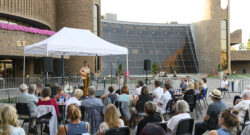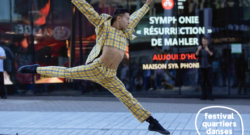Statistics Canada
Refreshing Performing Arts Statistics
Performing arts organizations did remarkably well in 2022 and are still on a growth curve in 2023.
Recovery continues in spite of inflation
The recovery of the live performance sector continued during the third quarter of 2022. Nominal GDP increased 2.8%. Jobs increased 5.3%.
Live performance sector picked up pace after lifting of restrictions
After a tough year’s start amid the sixth wave of the pandemic, the live performance sector bounced back in the second quarter of the year.
Recovery slowed down amid fifth wave
The GDP growth of the live performance sector stalled during the first quarter of 2021, but employment performed better than other sectors.
Encouraging signs of recovery for the performing arts
The GDP and employment increases observed over the second half of 2021 echo government interventions announced a year before.
Employment among arts and entertainment industries falls back to square one
According to the Labour Force Survey, employment among performing arts, spectator sports and related industries declined for a third consecutive month in January 2022.
Beginning of a resurgence in the performing arts
The live performance sector saw its first signs of a recovery during the third quarter of 2021.
No recovery in sight for the performing arts
Despite a gradual easing of public health restrictions in the provinces and territories, performing arts companies, presenters and festivals still showed no signs of economic recovery in the second quarter of 2021.
A closer look at the “hardest hit”: the National Culture Indicators for the first quarter of 2021
While the Canadian economy as a whole almost fully recovered from the impact of the COVID-19 pandemic, the culture sector still lags behind.
A close-up shot of the live performance domain – May not be suitable for sensitive viewers
New quarterly indicators released today by Statistics Canada provide an accurate measure of the profound impact of the COVID-19 pandemic on the live performance domain.
Employment in arts and culture industries, February 2021
While employment rebounded across the Canadian economy in February, the live performance sector took another dive. Self-employed artists and technicians, who had managed to hold on thanks to emergency support, are most severely impacted.
Government regulations and uncertainty about demand remain large obstacles for arts organizations
Government regulations were the top obstacle reported by arts, entertainment and recreation organizations, followed by demand-related concerns.
2020: The Year One in Four Arts Worker Lost Their Job
The COVID pandemic took a particularly heavy toll on the arts sector in 2020. One in four arts, entertainment and recreation workers lost their job in 2020, compared to 2019. That’s 114,400 artists, technicians, marketing staff, arts administrators and other cultural workers who could no longer earn...Read More
Employment in arts and culture industries, December 2020
Employment declined in most industries in December, including the arts sector and in cultural industries in December 2020.
Employment in arts and culture industries, November 2020
Last week, Minister of Finance Chrystia Freeland announced that certain “fiscal guardrails will help [the government] establish when the stimulus will be wound down.” One of these indicators – total hours worked – is particularly fitted to account for under-employment in sectors, such as the arts, t...Read More
Employment in arts and culture industries, October 2020
New public health restrictions ordered by provincial governments in response to spiking COVID-19 cases impacted many industries in October. Those that were already among the hardest hit reported further job losses.
Employment in arts and culture industries, September 2020
On September 22nd, nearly 700 venues lit up in red across the country to raise awareness of job losses among live event workers. As a matter of fact, all employment indicators in performing arts and entertainment industries once again fell in September.
Employment in arts and culture industries, August 2020
While the Canadian economy is slowly recovering, another 6,600 live performance workers lost their job in August.
Employment in arts and culture industries, July 2020
Nearly all arts, culture and heritage industries showed signs of recovery in July 2020. Employment in performing arts industries is still 23% below pre-COVID levels, but hours worked continued to rebound.
Employment in arts and culture industries, June 2020
Performing arts companies saw the largest decrease in total hours worked in June 2020: -73,5%.
Artists and cultural workers still among most impacted by the COVID outbreak
Employment in the information, culture and recreation industry was 83.1% of its pre-COVID level, the second-lowest proportion across all industries.
Employment rebounds, but culture workers aren’t seeing signs of recovery just yet
Between February and May 2020, 192,300 workers in information, culture and recreation industries lost their job. Employment declined from 778,700 to 586,400: a 24.7% drop.
Arts and entertainment among the most impacted by the COVID-19
According to Statistics Canada, businesses in the arts, entertainment and recreation sector are the most severely impacted by the COVID-19 crisis, along with accommodation and food.
























